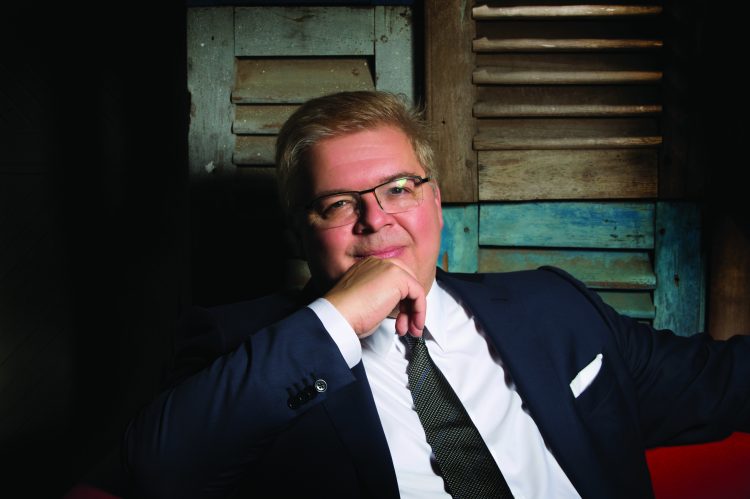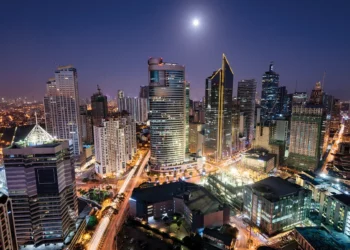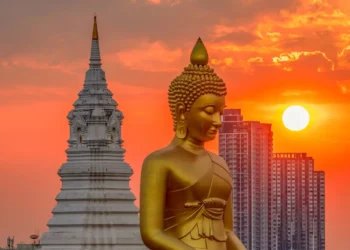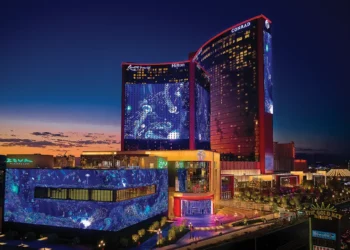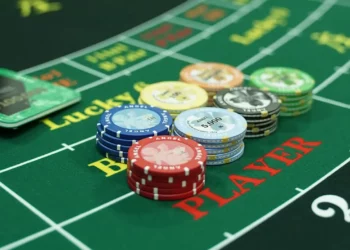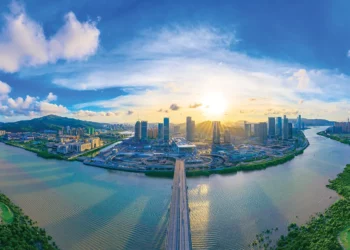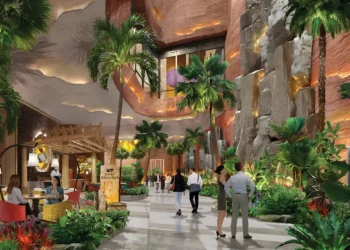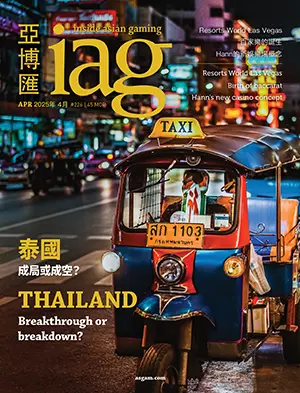Architect Paul Steelman provides his insights into designing the most expensive privately funded buildings on earth and making and breaking trends.
EMINENT casino architect Paul Steelman helped create the Asian gaming boom with the groundbreaking design of Sands Macao, opened in 2004. Since then, Steelman Partners has participated in casino projects across Asia, including Galaxy Macau, Solaire in Manila, Vietnam’s The Grand Ho Tram Strip and, most recently, Naga2 in Phnom Penh, as well as Genting Group’s Resorts World Las Vegas. At the Naga2 soft opening, the Atlantic City native turned Las Vegas resident discussed design with Inside Asian Gaming Editor-at-Large Muhammad Cohen.
Muhammad Cohen: How has Asian gaming shifted the paradigm for integrated resort design?
Paul Steelman: The creation of the Macau integrated resorts has changed everyone’s thinking towards gambling in a big way. One of the big things is that in Las Vegas we would make one very large room and then maybe a smaller baccarat room or something of this nature.
What Macau and Las Vegas Sands brought about was the era of the stratified casino where the casino was designed in five or six market segments. That has changed the IRs significantly, it has changed the buildings significantly, it has changed profitability significantly and it has changed the diversified set of operators that use any particular facility.
Now you have a series of junket representatives as well as people involved in the gaming floors in unusual capacities. There are slot machine providers and utilizers, there are junket reps and there are the main casinos doing their own super high limit VIP business.
What we found out from many of the Asian participants in this building was that they really wanted to be close to everything, whereas in a Las Vegas resort we pride ourselves on having one very large footplate where everyone can mingle and interact with one another. This has led us to a more vertical solution of casinos.
We started at Sands Macao with our stadium casino and also our high limit rooms on multiple levels because of the site size, and then we’ve continued that practice to Galaxy, to Solaire, to Ho Tram in Vietnam and all of our projects here in Asia.
MC: Did Sands Macao’s site size alone lead to the stadium casino?
PS: When we designed Sands Macao in 2003, we were given a long weekend – a Labor Day weekend – to design it. I was always impressed with the Chinese gamblers – how much they cheer and how much they back-bet. The only other place I’d experienced that was a little bit in France and a little bit in South Africa, but I was very impressed that they cheered almost like a team against the casino.
So, our basic idea that we shared with [LVS Chairman and CEO] Sheldon Adelson back then was the stadium casino that would take around 30,000 square feet of an approximately 175,000 square foot casino. That in fact allowed it to be opened to below on multiple levels and have a 60-foot ceiling, which at that time was unheard of. There was some reticence on Sheldon’s part but at the end of the day they realized it was only a small portion of the casino, not the whole thing, so they allowed it to occur.
It’s kind of funny, Steve Wynn called me a year-and-a-half ago and asked me, “How tall is that ceiling?” because he is now considering it in his Boston project – a higher ceiling – because he was the inventor, when we did the Mirage, of the idea that the ceilings had to be low.
MC: Is there something you know now about Asia that you wish you knew when you started?
PS: When we started Sands Macao we didn’t realize that the Asian customer wants the casino so much brighter. We didn’t actually realize that until we renovated StarWorld. We took a very dark casino and made it a very bright casino and the casino win metrics proved significantly that the Asian gambler wants the casino to be lighter, brighter, crisper than normal.
In Vegas it’s always a little bit about hiding. If you read some of the books about casino design from 10 or 15 years ago, they are all about creating confusing layouts with dark colors, dark lighting and things of this nature. I wish I had known in 2004 that we could have a brighter, more brilliant casino and in fact have it be more successful.
MC: How does integrated resort design respond to changes in the business model?
PS: Casinos have always been starting on the higher end. But casinos have changed drastically and their financial model has changed drastically.
The top casino in Las Vegas 10 years ago would make US$200 million to US$300 million a year, now the top casinos are making US$500 to US$600 million. It has doubled because of smarter operators, people working together and competition, but also the buildings. The buildings are designed to be more profitable.
There are lots of different ways to design a casino to be more profitable and in fact we have around 100 different rules to do that. We count steps in buildings, we use psychology in buildings to create empowerment in casinos and make it feel like you can win, to create “wow” only in the lobby so you’re not distracted from what you’re doing and even to create some kind of period of rest because no one can go on forever. We do all sorts of things like that.
So, our buildings are planned around metrics and that’s in the planning and the aesthetics, the layout of them, the lighting of them but, more importantly, they are planned around the cost. These are the most expensive private-funded buildings in the world and they have to make a profit. Those who spend too much going in the door without the proper business plan have some difficulties.
Stan Fulton [developer of “Wheel of Gold”, predecessor to the “Wheel of Fortune” slot machine, who died in January at age 86] told me as I was growing up, “Paul you have to realise that these casinos make their money 25 cents at a time.” You’ve got to keep that in the back of your mind whenever you’re designing a casino because this is not a series of efforts that have to do with extreme high rollers losing US$21 million. I’ve tried to always keep that in my mind, to try and do a value proposition rather than to try and lead the market.
Naga2 is a value proposition. The metrics on that building are remarkable – the amount of people per square meter, the cost per gaming position. If you were ever to compare those things you would be shocked. Some of the Macau casinos have 10 times the cost in a metric format than Naga2 does.
Your best customers are your residences, the people that are staying in the hotel, so the whole idea is to get as many people in residence as possible and the best way to do that is to plan an efficient hotel. Naga2 has to be one of the most efficient gaming hotels in the whole world.
MC: What do you think of themed properties?
PS: I love them, I think they’re fantastic. I don’t think themed properties should be themed as Disney would do it, though.
For example, Resorts World Las Vegas will be the first themed property on the Strip in 18 years. We believe in the themed property as a basis of where to head with the design. There is a modern interpretation of just about everything and that is what makes people feel really good about themselves. Take, for example, the motorcycle that I ride when I’m in America. It’s an Indian motorcycle. Why do I ride that? Well it’s modern, it’s got all the fancy gadgets – cruise control, anti-lock brakes and things like that – yet it’s a classic style.
The Sky Casino in Galaxy is one of the most successful casino spaces we’ve ever done and that is an interpretation of classical spaces. It doesn’t look and feel classical, it looks and feels as though it’s on its own. It looks like an architect from the 16th or 18th century could have designed it, but he would have designed it today. That is how we approach every themed project.
MC: How do culture and location impact IR design?
PS: Locations and cultures are interesting issues. We’ve designed casinos all over the world now and wherever it might be, we always respond to the various market conditions of the customers – always with a look of Las Vegas behind it.
Las Vegas is the most successful entertainment destination in the world and if you ask anyone in the world what they want to create in their first design meetings, it’s not necessarily to do something that the locals are totally familiar with, but it’s something that gives them that feeling of Las Vegas, that feeling of entertainment, feeling of excitement, feeling of empowerment, feeling that they look good and feeling of diversity in their product that it can do many things. Then we put a little bit of a local spin on it to make sure we accommodate not only the locals but also the different demographic groups – the millennials, baby boomers, Gen Y and so on. We try to do this in every job and we have our customers assist us because most of the time we don’t live there.
MC: What about millennials and casinos?
PS: We’re a little bit concerned about that, which is why we have made a new slot machine company, Competitive Interactive. Most of our customers have been asking us to predict the future. It takes us about five years to do one of these buildings, and what is in the future? We have designed many experimental casinos on paper right now for what the future might hold.
My children don’t play slot machines, most of their friends don’t play slot machines – the typical slot machine customer is typically going the way of the racebook customer. They’re getting older and not as much a part of the gaming scene. We have developed a slot machine called “Running Rich” which is a driving-based, skill-based slot machine. Now, once we develop the slot machine that will get the younger millennial gambler to possibly experience casinos, then the casino design will change.
We are looking at more indoor/outdoor designs of casinos – maybe there are more pools and recreational facilities directly outside the casino that interact well with it – and we are looking at casinos being more suited to color changing studies, digital projections within the casino. There are some VR [virtual reality] studies going on right now and we believe in the near future we will be doing things within the casino that will be organized in a VR way.
In terms of what the millennials actually want, it’s all over the board. We do not believe that architects coming up with the “hip” thing for that particular moment is good for these buildings. The hip thing is in one week and out the next. We can’t do what clothing brands do and design things for one season. These casinos are designed for 50 years. Of course, they get renovated every seven years but it takes that kind of futuristic thinking and I hope we’ll be a part of it.
MC: What structures are comparable to casinos? Are shopping malls like casinos?
PS: Shopping malls are definitely not like casinos and the casinos that are shopping malls are not successful. There are very, very few buildings like them because an integrated resort is a series of buildings. It’s a hotel, convention center, a theatre – an assembly building of sorts.
If I said, “What are these buildings like?” – they’re like giant transit centers, like train stations that have hotels on top of them or the Orlando airport without airplanes. That’s what these buildings are like. They have more people per square foot in them, they make more money than any other building, they are transient in nature – people come and go – and you must be 100% entertained, but you must be entertained how you want to be entertained. No one will force entertainment upon you. So, if I had to compare it to one building, it would be a train station in London or Grand Central.






